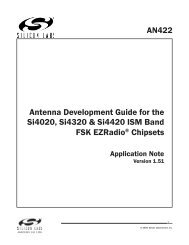C8051F326/7 - Silicon Labs
C8051F326/7 - Silicon Labs
C8051F326/7 - Silicon Labs
Create successful ePaper yourself
Turn your PDF publications into a flip-book with our unique Google optimized e-Paper software.
<strong>C8051F326</strong>/7<br />
6.3. Interrupt Handler<br />
The CIP-51 includes an extended interrupt system supporting a total of 8 interrupt sources with two priority<br />
levels. The allocation of interrupt sources between on-chip peripherals and external inputs pins varies<br />
according to the specific version of the device. Each interrupt source, with the exception of USB0, has one<br />
or more associated interrupt-pending flag(s) located in an SFR. USB0 interrupt sources are located in the<br />
USB registers. See Section “12.8. Interrupts” on page 101 for more details about the USB interrupt. When<br />
a peripheral or external source meets a valid interrupt condition, the associated interrupt-pending flag is<br />
set to logic 1.<br />
If interrupts are enabled for the source, an interrupt request is generated when the interrupt-pending flag is<br />
set. As soon as execution of the current instruction is complete, the CPU generates an LCALL to a predetermined<br />
address to begin execution of an interrupt service routine (ISR). Each ISR must end with an RETI<br />
instruction, which returns program execution to the next instruction that would have been executed if the<br />
interrupt request had not occurred. If interrupts are not enabled, the interrupt-pending flag is ignored by the<br />
hardware and program execution continues as normal. (The interrupt-pending flag is set to logic 1 regardless<br />
of the interrupt's enable/disable state.)<br />
Each interrupt source can be individually enabled or disabled through the use of an associated interrupt<br />
enable bit in an SFR (IE-EIE2). However, interrupts must first be globally enabled by setting the EA bit<br />
(IE.7) to logic 1 before the individual interrupt enables are recognized. Setting the EA bit to logic 0 disables<br />
all interrupt sources regardless of the individual interrupt-enable settings.<br />
Note: Any instruction which clears the EA bit should be immediately followed by an instruction which has two or more<br />
opcode bytes. For example:<br />
// in 'C':<br />
EA = 0; // clear EA bit<br />
EA = 0; // ... followed by another 2-byte opcode<br />
; in assembly:<br />
CLR EA ; clear EA bit<br />
CLR EA ; ... followed by another 2-byte opcode<br />
If an interrupt is posted during the execution phase of a "CLR EA" opcode (or any instruction that clears the<br />
EA bit), and the instruction is followed by a single-cycle instruction, the interrupt may be taken. If the EA bit<br />
is read inside the interrupt service routine, it will return a '0'. When the "CLR EA" opcode is followed by a<br />
multi-cycle instruction, the interrupt will not be taken.<br />
Some interrupt-pending flags are automatically cleared by the hardware when the CPU vectors to the ISR.<br />
However, most are not cleared by the hardware and must be cleared by software before returning from the<br />
ISR. If an interrupt-pending flag remains set after the CPU completes the return-from-interrupt (RETI)<br />
instruction, a new interrupt request will be generated immediately and the CPU will re-enter the ISR after<br />
the completion of the next instruction.<br />
6.3.1. MCU Interrupt Sources and Vectors<br />
The MCU supports 8 interrupt sources. Software can simulate an interrupt by setting any interrupt-pending<br />
flag to logic 1. If interrupts are enabled for the flag, an interrupt request will be generated and the CPU will<br />
vector to the ISR address associated with the interrupt-pending flag. MCU interrupt sources, associated<br />
vector addresses, priority order and control bits are summarized in Table 6.5 on page 50. Refer to the data<br />
sheet section associated with a particular on-chip peripheral for information regarding valid interrupt conditions<br />
for the peripheral and the behavior of its interrupt-pending flag(s).<br />
48 Rev. 1.1


